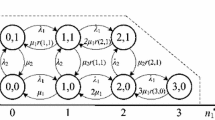Abstract
In this paper we consider an ATM transmission link, to which CBR or VBR and ABR or UBR calls arrive according to independent Poisson processes. CBR/VBR calls (characterized by their equivalent bandwidth) are blocked and leave the system if the available link capacity is less than required at the time of arrival. ABR/UBR calls, however, accept partial blocking, meaning that they may enter service even if the available capacity is less than the specified required peak bandwidth, but greater than the so called minimal accepted bandwidth. Partially blocked ABR/UBR calls instead experience longer service time, since smaller given bandwidth entails proportionally longer time spent in the system, as first suggested in [3] and analyzed in details herein. Throughout the life time of an ABR/UBR connection, its bandwidth consumption fluctuates in accordance with the current load on the link but always at the highest possible value up to their peak bandwidth (greedy sources). Additionally, if this minimal accepted bandwidth is unavailable at the time of arrival, ABR/UBR calls are allowed to wait in a finite queue. This system is modeled by a Continuous Time Markov Chain (CTMC) and the CBR/VBR and ABR/UBR blocking probabilities and the mean ABR/UBR waiting- and service times are derived.
Similar content being viewed by others
References
H. Akimaru, H. Kuribayashi and T. Inoue, Approximate evaluation for mixed delay and loss systems with renewal and Poisson inputs, IEEE Transactions on Communications 36(7) (1988) 850-854.
D. Anick, D. Mitra and M.M. Sondhi, Stochastic theory of a data-handling system with multiple sources, The Bell System Technical Journal 61 (1982) 1871-1894.
S. Blaabjerg and G. Fodor, A generalization of the multi-rate circuit switched loss model to model ABR services in ATM networks, in: Proc. of the IEEE Internat. Conf. on Communication Systems, ICCS'96, Vol. 2, Singapore, November 1996, pp. 17.4.1-17.4.5.
A. Bobbio and K.S. Trivedi, Computation of the distribution of the completion time when the work-load requirement is a PH random variable, Stochastic Models 6 (1990) 133-149.
G. Choudhury, K.K. Leung and W. Whitt, Efficiently providing multiple grade of service with protection against overloads in shared resources, AT&T Technical Journal (July/August 1995) 50-63.
E. Cinlar, Introduction to Stochastic Processes (Prentice-Hall, Englewood Cliffs, NJ, 1975).
A. Farago, S. Blaabjerg, L. Ast, G. Gordos and T. Henk, A new degree of freedom in ATM networks, IEEE Journal on Selected Areas in Communications 13(7) (September 1995).
G. Fodor, S. Blaabjerg and A.T. Andersen, Modeling and simulation of mixed queueing-and loss systems, Wireless Personal Communications 8(3) (August 1998) 233-256.
G. Fodor, S. Blaabjerg, A.T. Andersen and M. Telek, A partially blocking-queueing system with CBR/VBR and ABR/UBR arrival streams, in: IFIP WG 7.3 5th Internat. Conf. on Telecommunication Systems Modeling and Performance Analysis, Nashville, TN, USA, March 1997, pp. 411-424.
G. Fodor, E. Nordström and S. Blaabjerg, Revenue optimization and fairness control of priced guar-anteed and best effort services on an ATM transmission link, in: IEEE Internat. Conf. on Communications, ICC' 98, Vol. 3, Atlanta, GA, USA, June 1998, pp. 1696-1705.
G. Fodor, A. Racz and S. Blaabjerg, Simulative analysis of routing and link allocation strategies in ATM networks supporting aBR and UBR services, IEICE Transactions on Communications, Special Issue on ATM Traffic Control and Performance Evaluation E81-B(5) (May 1998) 985-995.
L.A. Gimpelson, Analysis of mixtures of wide-and narrow-band traffic, IEEE Transactions on Communication Technology (September 1965) 258-266.
W.K. Grassmann, M.I. Taksar and D.P. Heyman, Regenerative analysis and steady state distributions for Markov chains, Operations Research 33(5) (1985) 1107-1116.
R. Guérin, Queueing-blocking system with two arrival streams and guard channels, IEEE Transactions on Communications 36(2) (February 1988) 153-163.
R. Guérin, H. Ahmadi and M. Naghshineh, Equivalent capacity and its application to bandwidth allocation in high-speed networks, IEEE Journal on Selected Areas in Communications 9(7) (September 1991) 968-981.
D.P. Heyman Further comparisons of direct methods for computing stationary distributions of Markov chains, SIAM Journal of Algebra and Discrete Mathematics 8(2) (1987) 226-232.
J.S. Kaufman, Blocking in a completely shared resource environment with state dependent resource and residency requirements, in: IEEE Infocom, 1992.
D.K. Kin and C.K. Un, Performance analysis of bandwidth allocation strategy with state-dependent Bernoulli access and preemptive priority in wide-band integrated networks, Telecommunication Systems 4 (1995) 97-111.
D.K. Kim and C.K. Un, Performance analysis of bandwidth allocation strategy with state-dependent Bernoulli access and preemptive priority in wide-band integrated networks, Telecommunication Systems 4 (1995) 97-111.
D. Mitra, J.A. Morrison and K.G. Ramakrishnan, ATMnetwork design and optimization: A multi-rate loss network framework, IEEE/ACM Transactions on Networking 4(4) (August 1996) 531-543.
M.F. Neuts, Structured Stochastic Matrices of M/G/1 Type and Their Applications, Probability: Pure and Applied, Vol. 5 (Marcel Dekker, New York, 1989)
Z. Niu and H. Akimaru, Studies of mixed delay and non-delay systems in ATMnetworks, in: Internat.Teletraffic_Congress, ITC-13 (Elsevier Science, Amsterdam, 1991) pp. 515-520.
C.A. O'Cinneide, Entry-wise perturbation theory and error analysis for Markov chains, Numerical Mathematics 65 (1993) 109-120.
J.W. Roberts (ed.), Performance Evaluation and Design of Multi-Service Networks, COST 224 final report, October 1991 (Published by the Commission of the European Communities, Information Technologies and Sciences).
J.W. Roberts (ed.), Methods for the Performance Evaluation and Design of Broadband Multi-Service Networks, COST 242 final report, 1996 (Published by the Commission of the European Communities, Information Technologies and Sciences).
K.W. Ross, Multi-Service Loss Models for Broadband Telecommunication Networks (Springer, London, 1995).
Y.D. Serres and L.G. Mason, A multi-server queue with narrow-and wide-band customers and wide-band restricted access, IEEE Transactions on Communications 36 (1988) 675-684.
A. Smith, J. Adams and G. Tagg, Available bit rate - A new service for ATM, Computer Networks and ISDN Systems 28 (1995) 635-640.
Author information
Authors and Affiliations
Rights and permissions
About this article
Cite this article
Andersen, A.T., Blaabjerg, S., Fodor, G. et al. A Partially-Blocking Queueing System with CBR/VBR and ABR/UBR Arrival Streams. Telecommunication Systems 19, 75–99 (2002). https://doi.org/10.1023/A:1012242313914
Issue Date:
DOI: https://doi.org/10.1023/A:1012242313914




